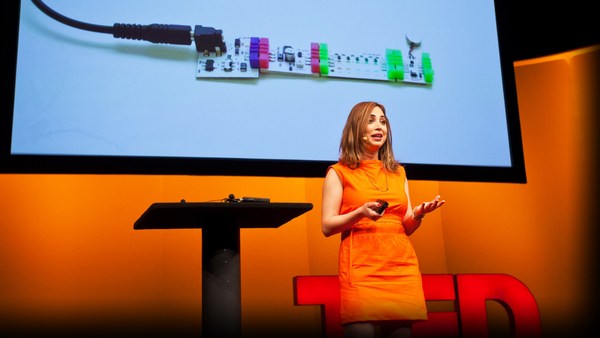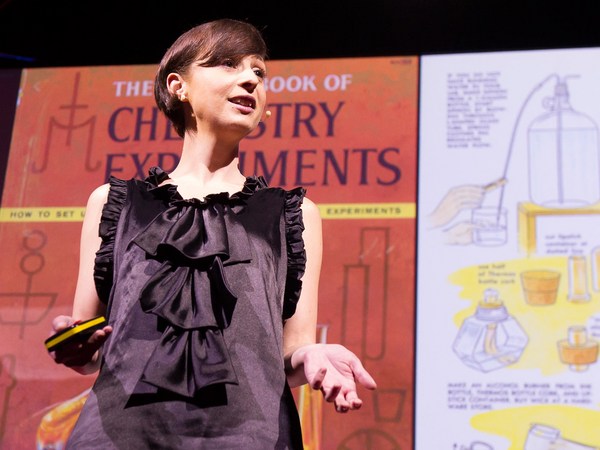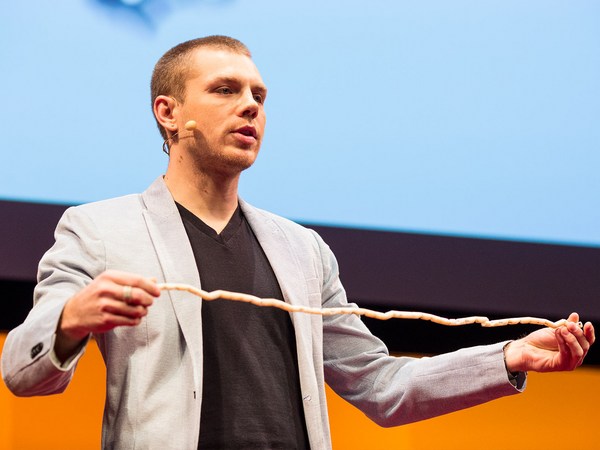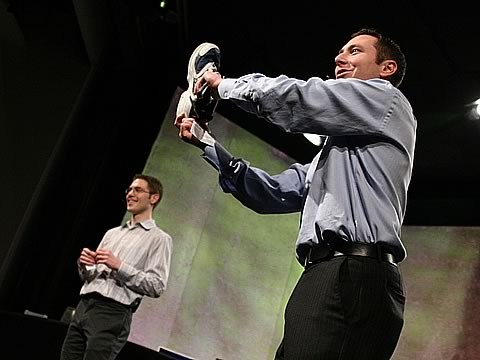Hey guys. It's funny, someone just mentioned MacGyver, because that was, like, I loved it, and when I was seven, I taped a fork to a drill and I was like, "Hey, Mom, I'm going to Olive Garden." And -- (Drilling noise) (Laughter) And it worked really well there. And you know, it had a profound effect on me. It sounds silly, but I thought, okay, the way the world works can be changed, and it can be changed by me in these small ways. And my relationship to especially human-made objects which someone else said they work like this, well, I can say they work a different way, a little bit.
And so, about 20 years later, I didn't realize the full effect of this, but I went to Costa Rica and I stayed with these Guaymí natives there, and they could pull leaves off of trees and make shingles out of them, and they could make beds out of trees, and they could -- I watched this woman for three days. I was there. She was peeling this palm frond apart, these little threads off of it, and she'd roll the threads together and make little thicker threads, like strings, and she would weave the strings together, and as the materiality of this exact very bag formed before my eyes over those three days, the materiality of the way the world works, of reality, kind of started to unravel in my mind, because I realized that this bag and these clothes and the trampoline you have at home and the pencil sharpener, everything you have is made out of either a tree or a rock or something we dug out of the ground and did some process to, maybe a more complicated one, but still, everything was made that way.
And so I had to start studying, who is it that's making these decisions? Who's making these things? How did they make them? What stops us from making them? Because this is how reality is created. So I started right away. I was at MIT Media Lab, and I was studying the maker movement and makers and creativity. And I started in nature, because I saw these Guaymís doing it in nature, and there just seems to be less barriers.
So I went to Vermont to Not Back to School Camp, where there's unschoolers who are just kind of hanging out and willing to try anything. So I said, "Let's go into the woods near this stream and just put stuff together, you know, make something, I don't care, geometrical shapes, just grab some junk from around you. We won't bring anything with us. And, like, within minutes, this is very easy for adults and teens to do. Here's a triangle that was being formed underneath a flowing stream, and the shape of an oak leaf being made by other small oak leaves being put together. A leaf tied to a stick with a blade of grass. The materiality and fleshiness and meat of the mushroom being explored by how it can hold up different objects being stuck into it. And after about 45 minutes, you get really intricate projects like leaves sorted by hue, so you get a color fade and put in a circle like a wreath.
And the creator of this, he said, "This is fire. I call this fire."
And someone asked him, "How do you get those sticks to stay on that tree?"
And he's like, "I don't know, but I can show you."
And I'm like, "Wow, that's really amazing. He doesn't know, but he can show you." So his hands know and his intuition knows, but sometimes what we know gets in the way of what could be, especially when it comes to the human-made, human-built world. We think we already know how something works, so we can't imagine how it could work. We know how it's supposed to work, so we can't suppose all the things that could be possible.
So kids don't have as hard of a time with this, and I saw in my own son, I gave him this book. I'm a good hippie dad, so I'm like, "Okay, you're going to learn to love the moon. I'm going to give you some building blocks and they're nonrectilinear cactus building blocks, so it's totally legit." But he doesn't really know what to do with these. I didn't show him. And so he's like, "Okay, I'll just mess around with this." This is no different than the sticks are to the teens in the forest. Just going to try to put them in shapes and push on them and stuff. And before long, he's kind of got this mechanism where you can almost launch and catapult objects around, and he enlists us in helping him.
And at this point, I'm starting to wonder, what kind of tools can we give people, especially adults, who know too much, so that they can see the world as malleable, so they see themselves as agents of change in their everyday lives. Because the most advanced scientists are really just kind of pushing the way the world itself works, pushing what matter can do, the most advanced artists are just pushing the medium, and any sufficiently complicated task, whether you're a cook or a carpenter or you're raising a child -- anything that's complicated -- comes up with problems that aren't solved in the middle of it, and you can't do a good job getting it done unless you can say, "Okay, well we're just going to have to refigure this. I don't care that pencils are supposed to be for writing. I'm going to use them a different way."
So let me show you a little demo. This is a little piano circuit right in here, and this is an ordinary paintbrush that I smashed it together with. (Beeping) And so, with some ketchup, — (musical notes) — and then I can kind of — (musical notes) — (Laughter) (Applause)
And that's awesome, right? But this is not what's awesome. What's awesome is what happens when you give the piano circuit to people. A pencil is not just a pencil. Look what it has in the middle of it. That's a wire running down the middle, and not only is it a wire, if you take that piano circuit, you can thumbtack into the middle of a pencil, and you can lay out wire on the page, too, and get electrical current to run through it. And so you can kind of hack a pencil, just by thumbtacking into it with a little piano electrical circuit.
And the electricity runs through your body too. And then you can take the little piano circuit off the pencil. You can make one of these brushes just on the fly. All you do is connect to the bristles, and the bristles are wet, so they conduct, and the person's body conducts, and leather is great to paint on, and then you can start hooking to everything, even the kitchen sink. The metal in the sink is conductive. Flowing water acts like a theremin or a violin.
(Musical notes)
And you can even hook to the trees. Anything in the world is either conductive or not conductive, and you can use those together.
So — (Laughter) — I took this to those same teens, because those teens are really awesome, and they'll try things that I won't try. I don't even have access to a facial piercing if I wanted to. And this young woman, she made what she called a hula-looper, and as the hula hoop traveled around her body, she has a circuit taped to her shirt right there. You can see her pointing to it in the picture. And every time the hula hoop would smush against her body, it would connect two little pieces of copper tape, and it would make a sound, and the next sound, and it would loop the same sounds over and over again.
I ran these workshops everywhere. In Taiwan, at an art museum, this 12-year-old girl made a mushroom organ out of some mushrooms that were from Taiwan and some electrical tape and hot glue. And professional designers were making artifacts with this thing strapped onto it. And big companies like Intel or smaller design firms like Ideo or startups like Bump, were inviting me to give workshops, just to practice this idea of smashing electronics and everyday objects together. And then we came up with this idea to not just use electronics, but let's just smash computers with everyday objects and see how that goes over.
And so I just want to do a quick demo. So this is the MaKey MaKey circuit, and I'm just going to set it up from the beginning in front of you. So I'll just plug it in, and now it's on by USB. And I'll just hook up the forward arrow. You guys are facing that way, so I'll hook it to this one. And I'll just hook up a little ground wire to it. And now, if I touch this piece of pizza, the slides that I showed you before should go forward. And now if I hook up this wire just by connecting it to the left arrow, I'm kind of programming it by where I hook it up, now I have a left arrow and a right arrow, so I should be able to go forwards and backwards and forwards and backwards. Awesome.
And so we're like, "We gotta put a video out about this." Because no one really believed that this was important or meaningful except me and, like, one other guy.
So we made a video to prove that there's lots of stuff you can do. You can kind of sketch with Play-Doh and just Google for game controllers. Just ordinary Play-Doh, nothing special. And you can literally draw joysticks and just find Pacman on your computer and then just hook it up. (Video game noises) And you know the little plastic drawers you can get at Target? Well, if you take those out, they hold water great, but you can totally cut your toes, so yeah, just be careful.
You know the Happiness Project, where the experts are setting up the piano stairs, and how cool that is? Well, I think it's cool, but we should be doing that stuff ourselves. It shouldn't be a set of experts engineering the way the world works. We should all be participating in changing the way the world works together.
Aluminum foil. Everybody has a cat. Get a bowl of water. This is just Photo Booth on your Mac OS. Hover the mouse over the "take a photo" button, and you've got a little cat photo booth.
And so we needed hundreds of people to buy this. If hundreds of people didn't buy this, we couldn't put it on the market. And so we put it up on Kickstarter, and hundreds of people bought it in the first day. And then 30 days later, 11,000 people had backed the project.
And then what the best part is, we started getting a flood of videos in of people doing crazy things with it. So this is "The Star-Spangled Banner" by eating lunch, including drinking Listerine. And we actually sent this guy materials. We're like, "We're sponsoring you, man. You're, like, a pro maker."
Okay, just wait for this one. This is good.
(Laughter) (Applause)
And these guys at the exploratorium are playing house plants as if they were drums. And dads and daughters are completing circuits in special ways.
And then this brother -- look at this diagram. See where it says "sister"? I love when people put humans on the diagram. I always add humans to any technical -- if you're drawing a technical diagram, put a human in it. And this kid is so sweet. He made this trampoline slideshow advancer for his sister so that on her birthday, she could be the star of the show, jumping on the trampoline to advance the slides. And this guy rounded up his dogs and he made a dog piano.
And this is fun, and what could be more useful than feeling alive and fun? But it's also very serious because all this accessibility stuff started coming up, where people can't use computers, necessarily. Like this dad who wrote us, his son has cerebral palsy and he can't use a normal keyboard. And so his dad couldn't necessarily afford to buy all these custom controllers. And so, with the MaKey MaKey, he planned to make these gloves to allow him to navigate the web. And a huge eruption of discussion around accessibility came, and we're really excited about that. We didn't plan for that at all.
And then all these professional musicians started using it, like at Coachella, just this weekend Jurassic 5 was using this onstage, and this D.J. is just from Brooklyn, right around here, and he put this up last month. And I love the carrot on the turntable.
(Music: Massive Attack — "Teardrop")
Most people cannot play them that way. (Laughter)
And when this started to get serious, I thought, I'd better put a really serious warning label on the box that this comes in, because otherwise people are going to be getting this and they're going to be turning into agents of creative change, and governments will be crumbling, and I wouldn't have told people, so I thought I'd better warn them. And I also put this little surprise. When you open the lid of the box, it says, "The world is a construction kit."
And as you start to mess around this way, I think that, in some small ways, you do start to see the landscape of your everyday life a little bit more like something you could express yourself with, and a little bit more like you could participate in designing the future of the way the world works.
And so next time you're on an escalator and you drop an M&M by accident, you know, maybe that's an M&M surfboard, not an escalator, so don't pick it up right away. Maybe take some more stuff out of your pockets and throw it down, and maybe some chapstick, whatever.
I used to want to design a utopian society or a perfect world or something like that. But as I'm kind of getting older and kind of messing with all this stuff, I'm realizing that my idea of a perfect world really can't be designed by one person or even by a million experts. It's really going to be seven billion pairs of hands, each following their own passions, and each kind of like a mosaic coming up and creating this world in their backyards and in their kitchens. And that's the world I really want to live in.
Thank you.
(Applause)





